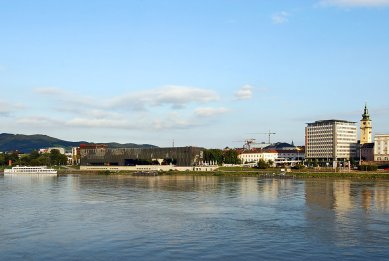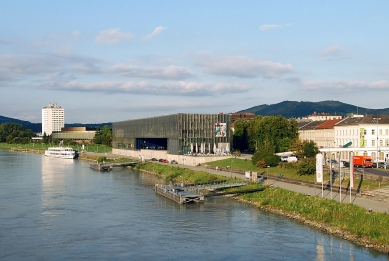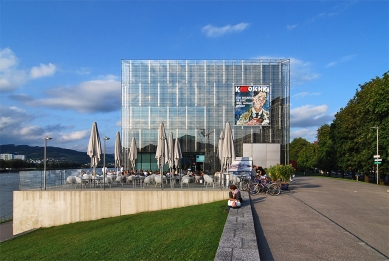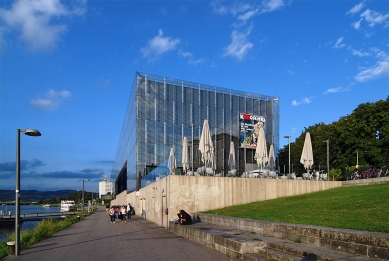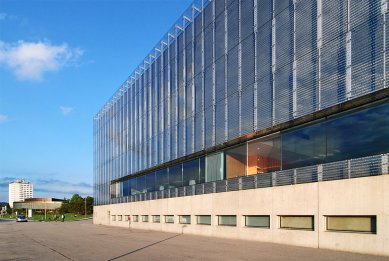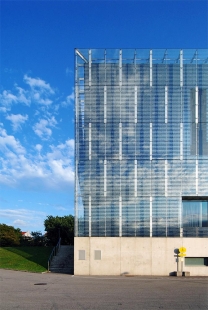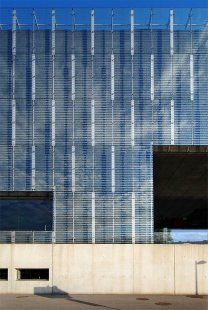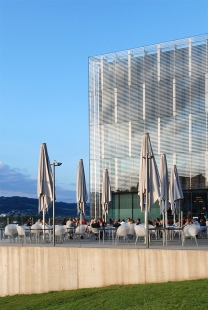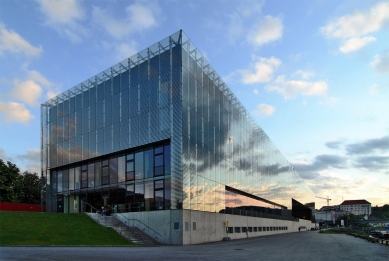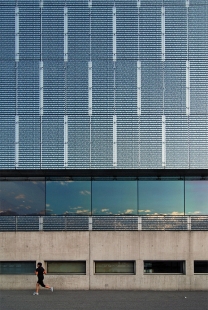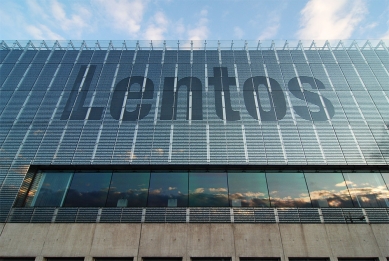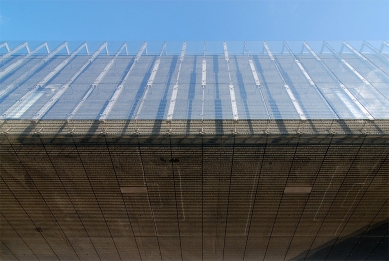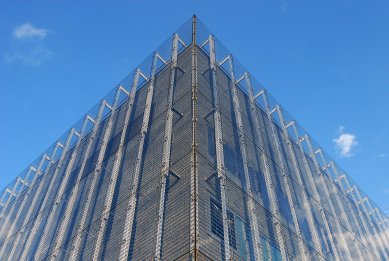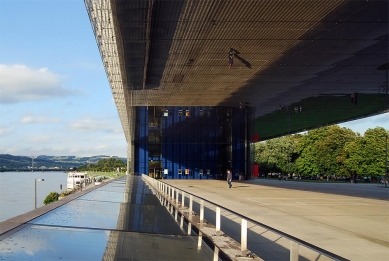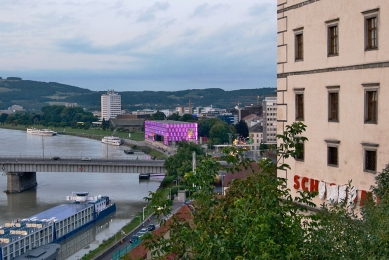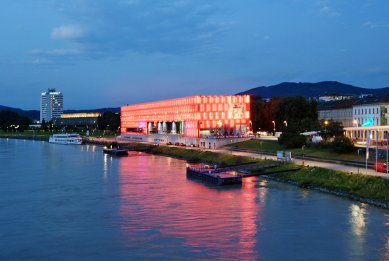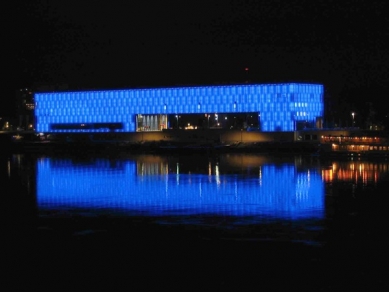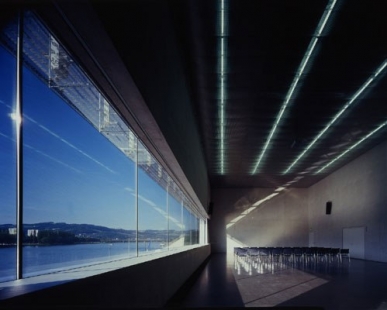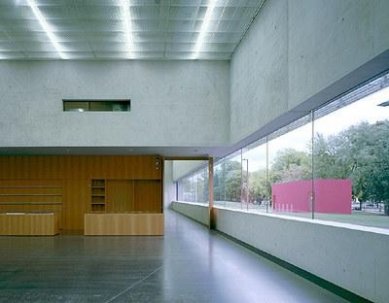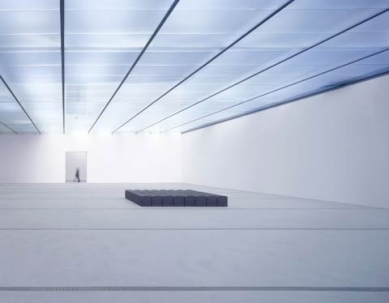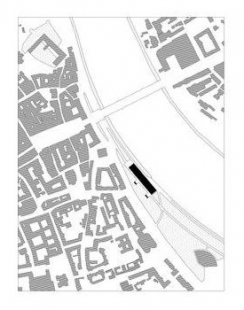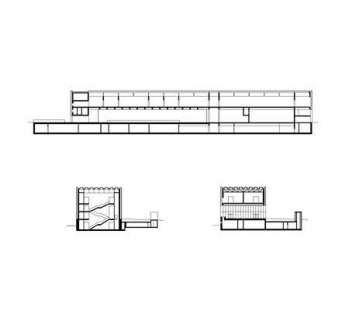
Lentos Museum

The Lentos Museum in the Austrian city of Linz, designed by Swiss architects Weber + Hofer, was opened in 2003 as a new gallery of classical and modern art, transcending its significance beyond the borders of the city and the country.
The museum appears as a ship, anchored on the banks of the Danube with splashing water on one side, surrounded by a park on the other. The building is excellently situated in the urban environment, right at the edge of the historic city center. The cubic structure concludes the public space of the park with freely placed sculptures by well-known artists (e.g., Max Bill - Bauhaus), along with adjacent buildings like the Music Pavilion and Brucknerhaus. The museum structure connects and unites both - the park and the city center - the Main Square with the pedestrian zone (Landstrasse). Two small red cement cubes with exits from the underground garage rise from the meadow and anchor the glass ship.
The construction made of exposed concrete is clad in glass panels, even from below the “free space - so-called Freiraum.” The glass envelope, with its endlessly reflecting text "lentos galerie," mirrors the surrounding light with varying intensity depending on the weather: from anthracite gray to sky blue, blending with the sky like a true mirror.
As an empty space without supports, "Freiraum" serves as both an urban square and the entrance hall for the museum, as well as a meeting place for visitors of the museum and the park. At the same time, it acts as a window to the Danube, offering a view up to the local landmark: Pöstlingberg, rising on the opposite bank of the Danube.
The motif of "framed views" continues inside the museum. Panoramic glass in the foyer, lecture hall, and training center provides a stunning view of the Danube and the city.
In the space between the concrete walls and the glass, lighting fixtures are mounted on the supporting frames of the glass, transforming the reflecting object by day into a light chameleon by night. At night, the building has a completely different effect than during the day. The subtlety and transparency of the object during the day contrast with the light effects in the nighttime hours. Linz has thus received not only a new house of art but also a permanent nightly light fireworks display.
The top floor with skylights encompasses eleven rooms totaling 1600 square meters for the permanent collection and a separate large exhibition room of 800 m², along with an art cabinet and reading room. The glass ceiling of the top floor transforms the building into a museum of daylight. In the exhibition rooms on the upper floor, glass is used as the primary source of light. The glass ceiling allows natural light to enter the room in a controlled manner, creating the desired lighting for the displayed works.
Through the over 60 m long, open entrance space “Freiraum,” which acts as a clean cut through the building, visitors arrive at the foyer, ticket counter, and sales area with catalogs, and then into a hall that accommodates 250 people and reading rooms. The western part of the ground floor features a café with a terrace. The extensive basement houses two additional exhibition spaces, a library, storage room, workshops, storages, and a reading room for graphic arts.
Spaces with unexpected views are a common theme throughout the entire building. In the space of the three-story staircase, visitors understand the vertical dimension of the building, spanning from the basement to the top floor. Here, glass and concrete dominate, with wall cladding made from steel fabric.
The exhibition rooms with an atmosphere of natural light are excellently suited for displaying large-format paintings by artists such as Markus Prachensky, Erich Steininger, Hubert Scheibl, Massimo Vitali, Sean Scully, or Jan Voss. The centrally placed sculpture by English artist Anthony Cragga is an especially remarkable exhibit of the museum. Its acquisition was made possible thanks to the generous support of friends of the visual arts in Vienna and friends of the Lentos Art Museum.
The museum appears as a ship, anchored on the banks of the Danube with splashing water on one side, surrounded by a park on the other. The building is excellently situated in the urban environment, right at the edge of the historic city center. The cubic structure concludes the public space of the park with freely placed sculptures by well-known artists (e.g., Max Bill - Bauhaus), along with adjacent buildings like the Music Pavilion and Brucknerhaus. The museum structure connects and unites both - the park and the city center - the Main Square with the pedestrian zone (Landstrasse). Two small red cement cubes with exits from the underground garage rise from the meadow and anchor the glass ship.
The construction made of exposed concrete is clad in glass panels, even from below the “free space - so-called Freiraum.” The glass envelope, with its endlessly reflecting text "lentos galerie," mirrors the surrounding light with varying intensity depending on the weather: from anthracite gray to sky blue, blending with the sky like a true mirror.
As an empty space without supports, "Freiraum" serves as both an urban square and the entrance hall for the museum, as well as a meeting place for visitors of the museum and the park. At the same time, it acts as a window to the Danube, offering a view up to the local landmark: Pöstlingberg, rising on the opposite bank of the Danube.
The motif of "framed views" continues inside the museum. Panoramic glass in the foyer, lecture hall, and training center provides a stunning view of the Danube and the city.
In the space between the concrete walls and the glass, lighting fixtures are mounted on the supporting frames of the glass, transforming the reflecting object by day into a light chameleon by night. At night, the building has a completely different effect than during the day. The subtlety and transparency of the object during the day contrast with the light effects in the nighttime hours. Linz has thus received not only a new house of art but also a permanent nightly light fireworks display.
The top floor with skylights encompasses eleven rooms totaling 1600 square meters for the permanent collection and a separate large exhibition room of 800 m², along with an art cabinet and reading room. The glass ceiling of the top floor transforms the building into a museum of daylight. In the exhibition rooms on the upper floor, glass is used as the primary source of light. The glass ceiling allows natural light to enter the room in a controlled manner, creating the desired lighting for the displayed works.
Through the over 60 m long, open entrance space “Freiraum,” which acts as a clean cut through the building, visitors arrive at the foyer, ticket counter, and sales area with catalogs, and then into a hall that accommodates 250 people and reading rooms. The western part of the ground floor features a café with a terrace. The extensive basement houses two additional exhibition spaces, a library, storage room, workshops, storages, and a reading room for graphic arts.
Spaces with unexpected views are a common theme throughout the entire building. In the space of the three-story staircase, visitors understand the vertical dimension of the building, spanning from the basement to the top floor. Here, glass and concrete dominate, with wall cladding made from steel fabric.
The exhibition rooms with an atmosphere of natural light are excellently suited for displaying large-format paintings by artists such as Markus Prachensky, Erich Steininger, Hubert Scheibl, Massimo Vitali, Sean Scully, or Jan Voss. The centrally placed sculpture by English artist Anthony Cragga is an especially remarkable exhibit of the museum. Its acquisition was made possible thanks to the generous support of friends of the visual arts in Vienna and friends of the Lentos Art Museum.
The English translation is powered by AI tool. Switch to Czech to view the original text source.
0 comments
add comment



